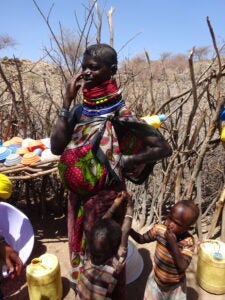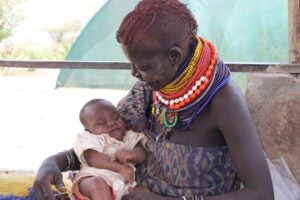In Turkana, a remote and arid region in Northeastern Kenya, water is so scarce that a pregnant woman, expected to be active until shortly before delivery, walks distances of up to 5 km to dig up for water with bare hands in dry riverbeds. Such heat stress can adversely affect the growth of her unborn child and increase the likelihood that she will have complications during childbirth. This risk isn’t unique to Turkana: many women and newborns globally are suffering devastating effects from global warming, which only compounds many other pre-existing vulnerabilities they already face.

This climate change-related catastrophe doesn’t make the headlines, not even in the context of the recently concluded Climate Change Conference (COP 26) talks. It does not look like the destruction caused by hurricanes, or the wildfires engulfing entire neighborhoods, or islands being swallowed by rising sea levels. This threat is silent and insidious, and already shaping generations to come.
Access to lifesaving, timely, and quality care during pregnancy, childbirth, and infancy is already a challenge in many low-income countries, most of which are also at highest risk of suffering the adverse impacts of the climate crisis. Expectant mothers and babies are disproportionately vulnerable to the effects of climate change for several reasons. Their reduced physiological capacity to regulate body temperature puts them at danger of serious complications from heat shock during recurring extreme heatwaves. Rising temperatures increase the spreading of vector-borne diseases such as malaria and dengue fever, which directly cause stillbirths, prematurity, and maternal deaths. Changing weather patterns lead to crop failures and food insecurity, causing malnutrition in pregnant and breast-feeding women who have inherently higher caloric demands, and who are in turn more likely to deliver low birth-weight babies and raise malnourished children.

The International Food Policy Research Institute projects that 25 million more children will be malnourished in 2050 as a direct result of climate change. Water scarcity increases the severity of diarrheal disease, already a leading cause of severe dehydration in pregnant women and in deaths of children under five. Extreme weather events also cause population displacement, conflict over scarce resources, and damage to key health infrastructure, all of which curtail access to essential care for women and babies.
In Turkana, temperatures have increased by 2-3°C in the last decades (compared to a 1°C global mean temperature increase in the last century). Cyclical droughts, more frequent and longer lasting, are decimating the herds of livestock, the main source of nutrition of the Turkana people. Malnourishment among pregnant and lactating women and children has become a critical challenge. Turkana has a Global Acute Malnutrition (GAM) level among infants and young children of 15-30%. (According to WHO, a GAM value greater than 10% indicates an emergency.) Water scarcity increases exposure to contaminated wells and to water-borne diseases. Historically a low-risk malaria zone, Turkana is now seeing its mosquito replication rate increasing. Rainfall is rare but torrential, and it regularly disrupts key services in the region, such as distribution of malaria nets.
Thanks to many collective efforts, a third fewer women die in childbirth globally today than two decades ago, but climate change is reversing this hard-won trend. And yet this reality has not made it on to our collective radar. Only a very small proportion of Nationally Determined Contributions, or NDCs (countries’ climate change commitments) mention pregnant women and newborns at all or quantify the impact of climate change mitigation efforts on their health. A promising outcome of COP 26 is that NDCs will be updated and revised annually (instead of every 5-years). That is an opportunity that we cannot miss to advocate for policies, targets and interventions specific to pregnant women and newborns to be included in NDCs in 2022. Our goal should be that by COP 27, a year from now, a majority of NDCs highlight specific, measurable actions to prevent the devastating impacts of climate change in early life and their far-reaching consequences over a lifetime and over generations.
Author Bio: Diana Perez Buck is founder of the non-profit Mothers at Risk and a graduate student at the Harvard Kennedy School
